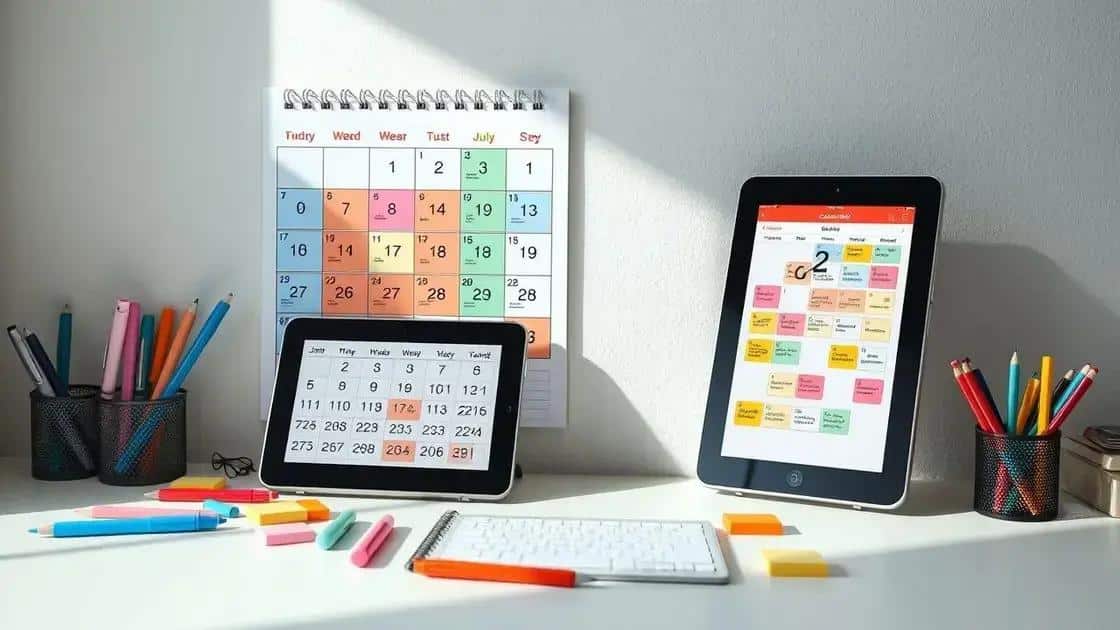Research academic year calendar: tools for success

Balancing academic and personal life involves creating a study schedule, setting clear priorities, minimizing distractions, and incorporating regular breaks to enhance productivity and overall well-being.
The research academic year calendar is an essential tool for students seeking to organize their time efficiently. Have you ever felt overwhelmed by deadlines and responsibilities? Let’s explore how a well-structured calendar can make all the difference.
Understanding the academic year calendar
Understanding the academic year calendar is crucial for students seeking to make the most of their educational journey. This calendar typically outlines important dates such as the start and end of semesters, holidays, and exam periods. By being aware of these dates, students can plan their studies effectively.
Key Components of the Academic Year Calendar
The academic year often consists of various terms or semesters, which can vary by institution. Knowing the structure helps in managing time better.
- Semesters: Most colleges operate on a two-semester system but some use quarter systems or trimesters.
- Holidays: Significant breaks are usually included, such as winter and spring breaks, which provide time for rest and study.
- Examination Periods: Knowing when exams are scheduled helps students prepare adequately.
- Registration Dates: Don’t forget to check when you can sign up for classes!
A clear understanding of the academic year calendar not only helps in academic planning but also aids in balancing personal life. When students know upcoming events and deadlines, they can allocate their time more efficiently.
Using the Academic Calendar Effectively
Once you have a grasp of the calendar, the next step is to utilize it to your advantage. Creating a personal planning tool using the calendar can simplify your studies.
Keep your calendar handy and mark down important dates such as assignment due dates and exam weeks. This proactive approach reduces stress and encourages punctuality.
Another tip is to communicate with peers about their schedules. Sometimes, group study sessions provide a better understanding of the material than studying alone. By aligning your academic calendar with study groups, you can actively engage with classmates and maximize learning.
Importance of planning your academic schedule
The importance of planning your academic schedule cannot be overstated. Having a structured approach allows students to manage their time effectively and prioritize their responsibilities. By plotting out your courses, deadlines, and exams, you set yourself up for success.
Benefits of a Well-Organized Schedule
A clear academic schedule provides several advantages. It helps you track what you need to accomplish each week, minimizing last-minute stress.
- Enhanced Time Management: Knowing what to expect helps you allocate time wisely, allowing for better balance.
- Reduced Anxiety: When you’re aware of deadlines, there’s less panic as due dates approach.
- Better Study Habits: Having a plan encourages regular study sessions, which can improve understanding and retention.
- Greater Flexibility: With a solid schedule, you can adjust and make changes when unexpected events occur.
Maintaining a well-organized academic schedule facilitates proactive learning. It also provides opportunities to plan for extracurricular activities or part-time jobs. Students who adapt their schedules often find they can harmonize work and study effectively.
Creating Your Academic Schedule
Start by listing all the courses you need to take. Include their timing and important dates such as examinations and project submissions. Once you have this information, use tools like planners or digital calendars. This helps produce a visual layout of your academic commitments.
Incorporating breaks and free time in your schedule is essential. It’s better to have a balanced approach rather than cramming everything. Breaks improve focus and productivity, so ensure you have time to refresh.
Tools to visualize your academic calendar

Using tools to visualize your academic calendar can greatly enhance your planning and organization. These tools help students track their schedules, assignments, and important deadlines in a clear and engaging manner. Whether you prefer digital or traditional methods, there are plenty of options available.
Digital Planning Tools
Many students find that digital planners make it easier to stay organized. Apps and online calendars allow you to access your schedule anytime and anywhere.
- Google Calendar: A versatile tool that syncs across devices and allows for setting reminders for deadlines.
- Trello: A board-based approach that lets you create tasks and move them along different stages.
- Notion: A powerful all-in-one workspace that helps you organize your academic tasks, notes, and calendar in one place.
- Microsoft Outlook: Combines email with calendar features, allowing scheduling and reminders linked to messages.
Digital tools not only provide visual clarity, but they also enable easy sharing with classmates or study groups. This fosters collaboration and helps everyone stay on the same page.
Traditional Planning Methods
For those who prefer a hands-on approach, traditional planners are still a great choice. Many students find writing things down helps them remember tasks more effectively.
A wall calendar is an excellent way to visualize your whole semester at a glance. You can also use color-coded sticky notes for different subjects or deadlines, making your schedule pop.
Combining these methods can also be effective. For instance, you might use a digital tool for daily planning while keeping a physical calendar for long-term goals. Ultimately, the key is to choose what method works best for your learning style.
How to balance academic and personal life
Finding a way to balance academic and personal life is essential for students. Striking a good balance allows you to enjoy life while staying on top of your studies. Understanding how to manage your time can lead to greater success both in and out of the classroom.
Setting Priorities
The first step in balancing your life is setting clear priorities. Knowing what needs your attention the most helps to keep stress levels low.
- Academic Responsibilities: Identify tasks and assignments that have the closest deadlines.
- Personal Activities: Consider your social life, hobbies, and relaxation time.
- Health and Well-being: Always prioritize your physical and mental health.
- Long-term Goals: Keep your long-term aspirations in mind to guide your daily choices.
After you have set your priorities, allocate time blocks for each of them. This prevents overload in one area while neglecting others.
Creating a Balanced Schedule
To achieve the right balance, creating a weekly schedule can help immensely. Begin by mapping out all classes, study sessions, and deadlines. Next, add in time for relaxation, socializing, and personal interests.
Remember to include downtime. Taking breaks in between study sessions improves focus and productivity. When you feel refreshed, you are more ready to tackle your academic obligations.
Cultivating a support system is another key element. Surrounding yourself with friends who understand your commitments can provide encouragement and also accountability, making it easier to stick to your plan.
Tips for optimizing your study time
Utilizing effective tips for optimizing your study time can make a significant difference in your academic performance. With a few strategies, you can enhance concentration, boost productivity, and retain information better.
Create a Study Schedule
The first step in optimizing study time is creating a consistent study schedule. Designate specific blocks of time for studying each subject. This helps to build a routine, making it easier to focus.
- Prioritize Subjects: Focus on difficult subjects first when your energy levels are highest.
- Use Short Study Sessions: Techniques like the Pomodoro Technique can help. Study for 25 minutes, then take a 5-minute break.
- Set Clear Goals: Define what you want to achieve in each study session, whether it’s reading a chapter or completing assignments.
- Review Regularly: Schedule time each week to review material learned. This reinforces your memory and understanding.
When you create a structured approach, you eliminate wasted time and maintain momentum.
Minimize Distractions
Another essential tip for optimizing your study time is to minimize distractions. Find a quiet space dedicated to studying where interruptions are limited. Turn off notifications on your devices and consider using apps that block distracting websites.
Focusing on your environment can greatly impact your productivity. A clutter-free desk encourages a clearer mind, so organize your workspace before you begin.
Additionally, try to communicate your study times to family and friends. When they know you’re studying, they are less likely to disturb you, allowing for deeper focus.
FAQ – Frequently Asked Questions about Balancing Academic and Personal Life
How can I create an effective study schedule?
Start by listing all your classes, deadlines, and commitments. Then, allocate specific blocks of time for each subject, ensuring to include breaks and personal activities.
What are some techniques to minimize distractions while studying?
Choose a quiet study environment, turn off notifications on your devices, and use apps that block distracting websites during study sessions.
Why is setting priorities important for students?
Setting priorities helps students focus on what needs immediate attention, reduces stress, and ensures important tasks are completed on time.
How can taking breaks improve my study efficiency?
Taking breaks helps refresh your mind, which can boost concentration and productivity when you return to studying, making your study sessions more effective.






